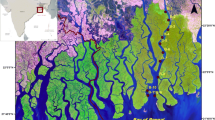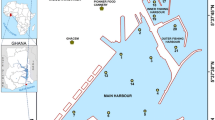Abstract
The geochemistry of coastal sediments of southern India was altered after the tsunami in 2004. A five-step sequential extraction procedure was applied to assess the effects of tsunami on mobility and redistribution of selected elements (Cd, Cr, Cu, Fe, Mn, Ni, Pb, and Zn). Ten surface sediments and three cores were analyzed for different metal fractions (exchangeable, carbonate, reduced, oxidized, and residual). Total metal concentrations increased in mangrove sediments after the tsunami, but their spatial distribution did not show significant variation (except Mn). The sediments were mixed by the tsunami, and there was lack of variation in metal concentrations in different fractions with depth (except Pb and Mn). High concentrations of Pb and Zn occurred in the oxide fractions, whereas Cu, Cr, Cd, and Ni were high in the organic and sulfide-rich fractions. Metals in the residual fraction (lattice bound) had the highest concentration suggesting their non-availability and limited biological uptake in the system. Most of the metals (except Mn) do not constitute a risk based on the different geochemical indices.






Similar content being viewed by others
References
Achterberg, E. P., van den Berg, C. M. G., Boussemart, M., & Davison, W. (1997). Speciation and cycling of trace metals in Esthwaite Water: a productive English lake with seasonal deep-water anoxia. Geochimica et Cosmochimica Acta, 61, 5233–5253.
Adriano, D. C. (2001). Trace elements in the terrestrial environments: biogeochemistry bioavailability, and risks of metals (pp. 47–71). New York: Springer.
Agoramoorthy, G., Chen, F.-A., & Hsu, M. J. (2008). Threat of heavy metal pollution in halophytic and mangrove plants of Tamil Nadu, India. Environmental Pollution, 155, 320–326.
Alongi, D. M., Ramanathan, A. L., Kannan, L., Tirendi, F., Trott, L. A., & Prasad, M. B. K. (2005). Human induced disturbances on benthic microbial metabolism in the Pichavaram mangroves, the Vellar–Coleroon estuarine complex, India. Marine Biology, 147, 1033–1044.
Babu, N., Suresh Babu, D. S., & Mohan Das, P. N. (2007). Impact of tsunami on texture and mineralogy of a major placer deposit in southwest coast of India. Environmental Geology, 52, 71–80.
Borges, A. V., Djenidi, S., Lacroix, G., Theate, J., Delille, B., & Frankignoule, M. (2003). Atmospheric CO2 fluxes from mangrove surrounding waters. Geophysical Research Letter, 30, 12–14.
Cappuyns, V., & Swennen, R. (2005). Kinetics of element release during combined oxidation and pH leaching of anoxic river sediments. Applied Geochemistry, 20, 1169–1179.
Cho, H.Y., Lakshumanan, C., & Natesan, U. (2004). Coastal wetland and shoreline change mapping of Pichavaram, south east coast of India using satellite data, 2004—Map Asia Conference, Beijing, China.
Cook, M.E., & Morrow, H. (1995). Anthropogenic sources of cadmium in Canada. National Workshop on Cadmium Transport Into Plants, Canadian Network of Toxicology Centres, Ottawa, Ontario, Canada, June 20-21, 1995.
El Bilali, L., Rasmussen, P. E., Hall, G. E. M., & Fortin, D. (2002). Role of sediment composition in trace metal distribution in lake sediments. Applied Geochemistry, 17, 1171–1181.
Farias, C. O., Hamacher, C., Wagener, A. D. L. R., de Campos, R. C., & Godoy, J. M. (2007). Trace metal contamination in mangrove sediments, Guanabara Bay, Rio de Janeiro, Brazil. Journal of the Brazilian Chemical Society, 18, 1194–1206.
Furukawa, K., Wolanski, E., & Mueller, H. (1997). Currents and sediments transport in mangrove forests. Estuarine, Coastal and Shelf Science, 44, 301–310.
Ghrefat, H., & Yusuf, N. (2006). Assessing Mn, Fe, Cu, Zn and Cd pollution in bottom sediments of Wadi Al-Arab Dam, Jordan. Chemosphere, 65, 2114–2121.
Green-Pedersen, H., Jensen, B. T., & Pind, N. (1997). Nickel adsorption on MnO2, Fe (OH)3, montmorillonite, humic acid and calcite: a comparative study. Environmental Technology, 18, 807–815.
Hseu, Z. Y. (2006). Extractability and bioavailability of zinc over time in three tropical soils incubated with biosolids. Chemosphere, 63, 762–771.
Huerta-Diaz, M. A., & Morse, J. W. (1992). Pyritization of trace metals in anoxic marine sediments. Geochimica et Cosmochimica Acta, 56, 2681–2702.
Jackson, M. L. (1973). Soil chemical analysis. New Delhi: Prentice Hall of India.
Jain, C. K. (2004). Metal fractionation study on bed sediments of River Yamuna, India. Water Research, 38, 569–578.
Jones, B., & Turkie, A. (1997). Distribution and speciation of heavy metals in surfacial sediments from the Tees Estuary, northwest England. Marine Pollution Bulletin, 34, 768–779.
Kathiresan, K. (2000). A review of studies on Pichavaram mangrove, southeast India. Hydrobiologia, 30, 185–205.
Kathiresan, K., & Rajendran, N. (2005). Coastal mangrove forests mitigated tsunami. Estuarine, Coastal and Shelf Science, 65, 601–606.
Koretsky, C. M., Haveman, M., Beuving, L., Cuellar, A., Shattuck, T., & Wagner, M. (2007). Spatial variation of redox and trace metal geochemistry in a mineralotrophic fen. Biogeochemistry, 86, 33–62.
Krupadam, R. J., Smita, P., & Wate, S. R. (2006). Geochemical fractionation of heavy metals in sediments of the Tapi estuary. Geochemical Journal, 40, 513–522.
Li, H., Feng, Y., Lu, S., & Du, Z. (2005). Bio-leaching of valuable metals from marine nodules under anaerobic condition. Minerals Engineering, 18, 1421–1422.
Li, Y., Yu, Z., Song, X., & Mu, Q. (2006). Trace metal concentrations in suspended particles, sediments and clams (Ruditapes philippinarum) from Jiaozhou bay of China. Environmental Monitoring and Assessment, 121, 491–501.
Long, E. R., MacDonald, D. D., Smith, S. L., & Calder, E. D. (1995). Incidence of adverse biological effects within ranges of chemical concentrations in marine and estuarine sediments. Environmental Management, 19, 81–97.
MacDonald, D., Carr, R., Calder, F., Long, E., & Ingersoll, C. (1996). Development and evaluation of sediment quality guidelines for Florida coastal waters. Ecotoxicology, 5, 253–278.
Marchand, C., Lallier-Vergès, E., Baltzer, F., Albe’rica, P., Cossa, D., & Baillif, P. (2006). Heavy metals distribution in mangrove sediments along the mobile coastline of French Guiana. Marine Chemistry, 98, 1–17.
Marchand, C., Fernandez, J.-M., Moreton, B., Landi, L., Lallier-Vergès, E., & Baltzer, F. (2012). The partitioning of transitional metals (Fe, Mn, Ni, Cr) in mangrove sediments downstream of a ferralitized ultramafic watershed (New Caledonia). Chemical Geology, 300(301), 70–80.
McLaughlin, M. J., Hamon, R. E., McLaren, R. G., Speir, T. W., & Rogers, S. L. (2000). Review: a bioavailability-based rationale for controlling metal and metalloid contamination of agricultural land in Australia and New Zealand. Australian Journal of Soil Research, 38, 1037–1086.
Mench, M. J. (1998). Cadmium availability to plants in relation to major long-term changes in agronomy systems. Agriculture, Ecosystems and Environment, 67, 175–187.
Morse, J. W., & Luther, G. W. (1999). Chemical influences on trace metal–sulphide interactions in anoxic sediments. Geochimica et Cosmochimica Acta, 63, 3373–3378.
Otero, X. L., & Macías, F. (2003). Spatial variation in pyritization of trace metals in salt-marsh soils. Biogeochemistry, 62, 59–86.
Pickering, W. F. (1986). Metal ion speciation—soil and sediments (a review). Ore Geology Reviews, 1, 83–146.
Ramanathan, A. L., Vaidhyanathan, P., Subramanian, V., & Das, B. K. (1993). Geochemistry of the Cauvery estuary, east coast of India. Estuaries, 16, 459–474.
Ramanathan, A. L., Subramanian, V., Ramesh, R., Chidambaram, S., & James, A. (1999). Environmental geochemistry of the Pichavaram mangrove ecosystem (tropical), southeast coast of India. Environmental Geology, 37, 223–233.
Ranjan, R. K., Ramanathan, A. L., & Singh, G. (2008a). Evaluation of geochemical impact of tsunami on Pichavaram mangrove ecosystem, southeast coast of India. Environmental Geology, 55, 687–697.
Ranjan, R. K., Ramanathan, A. L., Singh, G., & Chidambaram, S. (2008b). Assessment of metal enrichments in tsunamigenic sediments of Pichavaram mangroves, southeast coast of India. Environmental Monitoring and Assessment, 147, 389–411.
Salomons, W., & Förstner, V. (1984). Metals in the hydrocycle (p. 349). New York: Springer.
Satheeshkumar, G., Hameed, P. S., Meeramaideen, M., & Kannan, V. (2011). A post-tsunami study on the distribution and bioaccumulation of natural radionuclides in Pichavaram mangrove environment (South East Coast of India) and dose to local human population. Radiation Protection and Environment, 34, 96–103.
Scheffers, A., & Kelletat, D. (2003). Sedimentologic and geomorphic tsunami imprints worldwide—a review. Earth-Science Reviews, 63, 83–92.
Senthilkumar, B., Purvaja, R., & Ramesh, R. (2008). Seasonal and tidal dynamics of nutrients and chlorophyll a in a tropical mangrove estuary, southeast coast of India. Indian Journal of Marine Sciences, 37, 132–140.
Seralathan, P., Srinivasalu, S., Ramanathan, A. L., Rajamanickam, G. V., Nagendra, R., Singarasubramanian, S. R., et al. (2006). Post tsunami sediments characteristics of Tamilnadu Coast. In G. V. Rajamanickam (Ed.), 26th December 2004 tsunami causes, effects remedial measures, pre and post tsunami disaster management, a geoscientific perspective (pp. 124–149). New Delhi: New Academic.
Shapiro, X. L. (1975). Rapid analysis of silicate, carbonate and phosphate rocks, revised edition. USGS, Bulletin, 1401, 1–54.
Srinivasalu, S., Thangadurai, N., Jonathan, M. P., Armstrong-Altrin, J. S., Ayyamperumal, T., & Ram-Mohan, V. (2008). Evaluation of trace-metal enrichments from the 26 December 2004 tsunami sediments along the southeast coast of India. Environmental Geology, 53, 1711–1721.
Szczucinski, W., Niedzielski, P., Rachlewicz, G., Sobczynski, T., Ziola, A., Kowalski, A., et al. (2005). Contamination of tsunami sediments in a coastal zone inundated by the 26 December 2004 tsunami in Thailand. Environmental Geology, 49, 321–331.
Tam, N. F. Y., & Wong, W. S. (2000). Spatial variation of heavy metals in surface sediments of Hong Kong mangrove swamps. Environmental Pollution, 110, 195–205.
Tessier, A., Campbell, P. G. C., & Bisson, M. (1979). Sequential extraction procedure for the speciation of particulate traces metals. Analytical Chemistry, 51, 844–851.
Turkian, K. K., & Wedepohl, K. H. (1961). Distribution of the elements in some major units of the earth crust. Bulletin Geological Society of America, 72, 175–192.
World Health Organisation (WHO) (1992). Environmental Health Criteria 134—Cadmium International Programme on Chemical Safety (IPCS) Monograph.
Yan, C., Li, Q., Zhang, X., & Li, G. (2010). Mobility and ecological risk assessment of heavy metals in surface sediments of Xiamen Bay and its adjacent areas, China. Environmental Earth Science, 60, 1469–1479.
Yim, M. W., & Tam, N. F. Y. (1999). Effects of wastewater-borne heavy metals on mangrove plants and soil microbial activities. Marine Pollution Bulletin, 39, 179–186.
Acknowledgments
We acknowledge the Principal Chief Conservator of Forests, Government of Tamil Nadu and Divisional Forest Officer, Villupuram for permission to sample the Pichavaram mangroves. We thank Sanjeev Bakshi (CUB, Patna) with the statistical analysis. Thoughtful reviews by both reviewers significantly helped in improving the manuscript. RKR acknowledges Sat Paul Mittal Trust. Funding was provided by FORMAS.
Author information
Authors and Affiliations
Corresponding author
Electronic supplementary material
Below is the link to the electronic supplementary material.
ESM 1
(DOCX 1087 kb)
Rights and permissions
About this article
Cite this article
Ranjan, R.K., Singh, G., Routh, J. et al. Trace metal fractionation in the Pichavaram mangrove–estuarine sediments in southeast India after the tsunami of 2004. Environ Monit Assess 185, 8197–8213 (2013). https://doi.org/10.1007/s10661-013-3167-6
Received:
Accepted:
Published:
Issue Date:
DOI: https://doi.org/10.1007/s10661-013-3167-6




